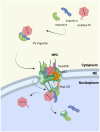Nuclear entry and egress of parvoviruses
- PMID: 35974704
- PMCID: PMC9805091
- DOI: 10.1111/mmi.14974
Nuclear entry and egress of parvoviruses
Abstract
Parvoviruses are small non-enveloped single-stranded DNA viruses, which depend on host cell nuclear transcriptional and replication machinery. After endosomal exposure of nuclear localization sequence and a phospholipase A2 domain on the capsid surface, and escape into the cytosol, parvovirus capsids enter the nucleus. Due to the small capsid diameter of 18-26 nm, intact capsids can potentially pass into the nucleus through nuclear pore complexes (NPCs). This might be facilitated by active nuclear import, but capsids may also follow an alternative entry pathway that includes activation of mitotic factors and local transient disruption of the nuclear envelope. The nuclear entry is followed by currently undefined events of viral genome uncoating. After genome release, viral replication compartments are initiated and infection proceeds. Parvoviral genomes replicate during cellular S phase followed by nuclear capsid assembly during virus-induced S/G2 cell cycle arrest. Nuclear egress of capsids occurs upon nuclear envelope degradation during apoptosis and cell lysis. An alternative pathway for nuclear export has been described using active transport through the NPC mediated by the chromosome region maintenance 1 protein, CRM1, which is enhanced by phosphorylation of the N-terminal domain of VP2. However, other alternative but not yet uncharacterized nuclear export pathways cannot be excluded.
Keywords: import and export; nuclear envelope; nuclear pore complexes; nucleus; parvoviruses.
© 2022 The Authors. Molecular Microbiology published by John Wiley & Sons Ltd.
Figures



Similar articles
-
Cytoplasmic Parvovirus Capsids Recruit Importin Beta for Nuclear Delivery.J Virol. 2020 Jan 31;94(4):e01532-19. doi: 10.1128/JVI.01532-19. Print 2020 Jan 31. J Virol. 2020. PMID: 31748386 Free PMC article.
-
Protoparvovirus Knocking at the Nuclear Door.Viruses. 2017 Oct 2;9(10):286. doi: 10.3390/v9100286. Viruses. 2017. PMID: 28974036 Free PMC article. Review.
-
CRM1 Promotes Capsid Disassembly and Nuclear Envelope Translocation of Adenovirus Independently of Its Export Function.J Virol. 2022 Feb 9;96(3):e0127321. doi: 10.1128/JVI.01273-21. Epub 2021 Nov 10. J Virol. 2022. PMID: 34757845 Free PMC article.
-
Nucleoporin 153 arrests the nuclear import of hepatitis B virus capsids in the nuclear basket.PLoS Pathog. 2010 Jan 29;6(1):e1000741. doi: 10.1371/journal.ppat.1000741. PLoS Pathog. 2010. PMID: 20126445 Free PMC article.
-
Intracellular transport and egress of hepatitis B virus.J Hepatol. 2016 Apr;64(1 Suppl):S49-S59. doi: 10.1016/j.jhep.2016.02.008. J Hepatol. 2016. PMID: 27084037 Review.
Cited by
-
Temporal insights into molecular and cellular responses during rAAV production in HEK293T cells.Mol Ther Methods Clin Dev. 2024 Jun 8;32(3):101278. doi: 10.1016/j.omtm.2024.101278. eCollection 2024 Sep 12. Mol Ther Methods Clin Dev. 2024. PMID: 39022743 Free PMC article.
-
Probing recombinant AAV capsid integrity and genome release after thermal stress by mass photometry.Mol Ther Methods Clin Dev. 2024 Jun 24;32(3):101293. doi: 10.1016/j.omtm.2024.101293. eCollection 2024 Sep 12. Mol Ther Methods Clin Dev. 2024. PMID: 39100914 Free PMC article.
-
MA104 cell line is permissive for human bocavirus 1 infection.J Virol. 2025 Feb 25;99(2):e0153924. doi: 10.1128/jvi.01539-24. Epub 2025 Jan 23. J Virol. 2025. PMID: 39846742 Free PMC article.
-
HBoV-1: virus structure, genomic features, life cycle, pathogenesis, epidemiology, diagnosis and clinical manifestations.Front Cell Infect Microbiol. 2023 May 17;13:1198127. doi: 10.3389/fcimb.2023.1198127. eCollection 2023. Front Cell Infect Microbiol. 2023. PMID: 37265497 Free PMC article. Review.
-
Biophysical and structural insights into AAV genome ejection.J Virol. 2025 Mar 18;99(3):e0089924. doi: 10.1128/jvi.00899-24. Epub 2025 Feb 5. J Virol. 2025. PMID: 39907279 Free PMC article.
References
-
- Abschuetz, A. , Kehl, T. , Geibig, R. , Leuchs, B. , Rommelaere, J. & Régnier‐Vigouroux, A. (2006) Oncolytic murine autonomous parvovirus, a candidate vector for glioma gene therapy, is innocuous to normal and immunocompetent mouse glial cells. Cell and Tissue Research, 325, 423–436. 10.1007/S00441-006-0199-Z/FIGURES/8 - DOI - PubMed
-
- Arora, R. , Malla, W.A. , Tyagi, A. , Mahajan, S. , Sajjanar, B. & Tiwari, A.K. (2021) Canine parvovirus and its non‐structural gene 1 as oncolytic agents: mechanism of action and induction of anti‐tumor immune response. Frontiers in Oncology, 11, 1290. 10.3389/FONC.2021.648873/BIBTEX - DOI - PMC - PubMed
Publication types
MeSH terms
Substances
LinkOut - more resources
Full Text Sources
Other Literature Sources

